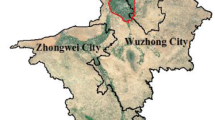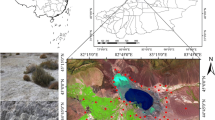Abstract
Soil salinization is a serious ecological and environmental problem because it adversely affects sustainable development worldwide, especially in arid and semi-arid regions. It is crucial and urgent that advanced technologies are used to efficiently and accurately assess the status of salinization processes. Case studies to determine the relations between particular types of salinization and their spectral reflectances are essential because of the distinctive characteristics of the reflectance spectra of particular salts. During April 2015 we collected surface soil samples (0–10 cm depth) at 64 field sites in the downstream area of Minqin Oasis in Northwest China, an area that is undergoing serious salinization. We developed a linear model for determination of salt content in soil from hyperspectral data as follows. First, we undertook chemical analysis of the soil samples to determine their soluble salt contents. We then measured the reflectance spectra of the soil samples, which we post-processed using a continuum-removed reflectance algorithm to enhance the absorption features and better discriminate subtle differences in spectral features. We applied a normalized difference salinity index to the continuum-removed hyperspectral data to obtain all possible waveband pairs. Correlation of the indices obtained for all of the waveband pairs with the wavebands corresponding to measured soil salinities showed that two wavebands centred at wavelengths of 1358 and 2382 nm had the highest sensitivity to salinity. We then applied the linear regression modelling to the data from half of the soil samples to develop a soil salinity index for the relationships between wavebands and laboratory measured soluble salt content. We used the hyperspectral data from the remaining samples to validate the model. The salt content in soil from Minqin Oasis were well produced by the model. Our results indicate that wavelengths at 1358 and 2382 nm are the optimal wavebands for monitoring the concentrations of chlorine and sulphate compounds, the predominant salts at Minqin Oasis. Our modelling provides a reference for future case studies on the use of hyperspectral data for predictive quantitative estimation of salt content in soils in arid regions. Further research is warranted on the application of this method to remotely sensed hyperspectral data to investigate its potential use for large-scale mapping of the extent and severity of soil salinity.
Similar content being viewed by others
References
Bao S D. 2000. Soil Agricultural Chemistry Analysis. Beijing: China Agriculture Press, 178–198. (in Chinese)
Barrett-Lennard E G. 2003. The interaction between waterlogging and salinity in higher plants: causes, consequences and implications. Plant and Soil, 253(1): 35–54.
Ben-Dor E, Banin A. 1995. Near-infrared analysis as a rapid method to simultaneously evaluate several soil properties. Soil Science Society of America Journal, 59(2): 364–372.
Ben-Dor E, Chabrillat S, Demattê J A M, et al. 2009. Using imaging spectroscopy to study soil properties. Remote Sensing of Environment, 113(Suppl. 1): S38–S55.
Bondes M, Li D. 2013. Climate Change and Sustainable Development in Western China's Minqin Oasis: Joining Forces with Society. In: Vajpeyi D. Climate Change, Sustainable Development and Human Security. New York: Lexington, 139–168.
Chen L, Feng Q, Li C, et al. 2016. Spatial variations of soil microbial activities in saline groundwater-irrigated soil ecosystem. Environmental Management, 57(5): 1054–1061.
Clark R N, Roush T L. 1984. Reflectance spectroscopy: Quantitative analysis techniques for remote sensing applications. Journal of Geophysical Research: Solid Earth, 89(B7): 6329–6340.
Crowley J K. 1991. Visible and near-infrared (0.4–2.5 μm) reflectance spectra of Playa evaporate minerals. Journal of Geophysical Research: Solid Earth, 96(B10): 16231–16240.
Danner M, Locherer M, Hank T, et al. 2015. Spectral Sampling with the ASD FieldSpec 4-Theory, Measurement, Problems, Interpretation. In: EnMAP Field Guides Technical Report. GFZ Data Services. Brandenburg, Germany.
Dehaan R, Taylor G R. 2003. Image-derived spectral endmembers as indicators of salinisation. International Journal of Remote Sensing, 24(4): 775–794.
Ding J L, Wu M C, Tiyip T. 2011. Study on soil salinization information in arid region using remote sensing technique. Agricultural Sciences in China, 10(3): 404–411.
Douaoui A E K, Nicolas H, Walter C. 2006. Detecting salinity hazards within a semiarid context by means of combining soil and remote-sensing data. Geoderma, 134(1–2): 217–230.
Dwivedi R S. 2001. Soil resources mapping: A remote sensing perspective. Remote Sensing Reviews, 20(2): 89–122.
Fan X, Liu Y, Tao J, et al. 2015. Soil salinity retrieval from advanced multi-spectral sensor with partial least square regression. Remote Sensing, 7(1): 488–511.
Farifteh J, Farshad A, George R J. 2006. Assessing salt-affected soils using remote sensing, solute modelling, and geophysics. Geoderma, 130(3–4): 191–206.
Farifteh J, Van der Meer F, Atzberger C, et al. 2007. Quantitative analysis of salt-affected soil reflectance spectra: A comparison of two adaptive methods (PLSR and ANN). Remote Sensing of Environment, 110(1): 59–78.
Farifteh J, Van der Meer F, Van der Meijde M, et al. 2008. Spectral characteristics of salt-affected soils: A laboratory experiment. Geoderma, 145(3–4): 196–206.
Femández-Bucs N, Siebe C, Cram S, et al. 2006. Mapping soil salinity using a combined spectral response index for bare soil and vegetation: A case study in the former lake Texcoco, Mexico. Journal of Arid Environments, 65(4): 644–667.
Goetz A F H. 2009. Three decades of hyperspectral remote sensing of the Earth: A personal view. Remote Sensing of Environment, 113(Suppl. 1): S5–S16.
Gomez C, Viscarra Rossel R A, McBratney A B. 2008. Soil organic carbon prediction by hyperspectral remote sensing and field vis-NIR spectroscopy: An Australian case study. Geoderma, 146(3–4): 403–411.
Haubrock S N, Chabrillat S, Kuhnert M, et al. 2008a. Surface soil moisture quantification and validation based on hyperspectral data and field measurements. Journal of applied remote sensing, 2(1): 1–26.
Haubrock S N, Chabrillat S, Lemmnitz C, et al. 2008b. Surface soil moisture quantification models from reflectance data under field conditions. International Journal of Remote Sensing, 29(1): 3–29.
Howari F M, Goodell P C, Miyamoto S. 2002. Spectral properties of salt crusts formed on saline soils. Journal of Environmental Quality, 31(5): 1453–1461.
Huang Z, Turner B J, Dury S J, et al. 2004. Estimating foliage nitrogen concentration from HYMAP data using continuum removal analysis. Remote Sensing of Environment, 93(1–2): 18–29.
Hunt G R. 1977. Spectral signatures of particulate minerals in the visible and near infrared. Geophysics, 42(3): 501–513.
Li J, Pu L, Han M, et al. 2014. Soil salinization research in China: Advances and prospects. Journal of Geographical Sciences, 24(5): 943–960.
Lu P, Wang L, Niu Z, et al. 2013. Prediction of soil properties using laboratory VIS-NIR spectroscopy and Hyperion imagery. Journal of Geochemical Exploration, 132(Suppl. C): 26–33.
Ma J Z, Wang X S, Edmunds W M. 2005. The characteristics of ground-water resources and their changes under the impacts of human activity in the arid Northwest China—a case study of the Shiyang River Basin. Journal of Arid Environments, 61(2): 277–295.
Ma Y, Fan S, Zhou L, et al. 2007. The temporal change of driving factors during the course of land desertification in arid region of North China: the case of Minqin County. Environmental Geology, 51(6): 999–1008.
Mashimbye Z E. 2013. Remote sensing of salt-affected soils. PhD Dissertation. Western Cape: Stellenbosch University, 98.
Metternicht G I, Zinck J A. 2003. Remote sensing of soil salinity: potentials and constraints. Remote Sensing of Environment, 85(1): 1–20.
Mougenot B, Pouget M, Epema G F. 1993. Remote sensing of salt affected soils. Remote Sensing Reviews, 7(3–4): 241–259.
Munns R. 2002. Comparative physiology of salt and water stress. Plant, Cell & Environment, 25(2): 239–250.
Qian T N, Tsunekawa A, Masunaga T, et al. 2017. Analysis of the Spatial Variation of Soil Salinity and Its Causal Factors in China's Minqin Oasis. Mathematical Problems in Engineering, Vol. 2017. https://doi.org/10.1155/2017/9745264.
Rengasamy P. 2006. World salinization with emphasis on Australia. Journal of Experimental Botany, 57(5): 1017–1023.
Sheng J, Ma L, Jiang P, et al. 2010. Digital soil mapping to enable classification of the salt-affected soils in desert agro-ecological zones. Agricultural Water Management, 97(12): 1944–1951.
Shi X Z, Yu D S, Yang G X, et al. 2006. Cross-reference benchmarks for translating the Genetic Soil Classification of China into the Chinese Soil Taxonomy. Pedosphere, 16(2): 147–153.
Thomas G W. 1996. Soil pH and soil acidity. In: Sparks R S L, Swift D. L. Methods of Soil Analysis. Part 3-Chemical Methods. Madison: Soil Science Society of America, 475–490.
Wang Q, Li P, Chen X. 2012. Modeling salinity effects on soil reflectance under various moisture conditions and its inverse application: A laboratory experiment. Geoderma, 170: 103–111.
Wang Y, Li Y, Xiao D. 2008. Catchment scale spatial variability of soil salt content in agricultural oasis, Northwest China. Environmental Geology, 56(2): 439–446.
Wang Y, Deng C, Liu Y, et al. 2018. Identifying change in spatial accumulation of soil salinity in an inland river watershed, China. Science of the Total Environment, 621: 177–185.
Wang Z. 1993. Chinese Saline-Alkaline Soil. Beijing: Science Press, 335. (in Chinese)
Wei H, Li Y, Xu C D, et al. 2016. The process of cultivated land and water resource distribution changing in recent decades in upstream and downstream in Shiyang Inland River Basin in arid area of Northwest China. Journal of Geoscience and Environment Protection, 4(7): 166–171.
Weng Y, Gong P, Zhu Z. 2010. A spectral index for estimating soil salinity in the Yellow River Delta Region of China using EO-1 Hyperion data. Pedosphere, 20(3): 378–388.
Wild A. 2003. Soils, Land and Food: Managing the Land during the Twenty-First Century. Cambridge: Cambridge University Press, 84–85.
Xiao D, Li X, Song D, et al. 2007. Temporal and spatial dynamical simulation of groundwater characteristics in Minqin Oasis. Science in China Series D: Earth Sciences, 50(2): 261–273.
Zhang F, Tiyip T, Ding J, et al. 2003. Studies on the reflectance spectral features of saline soil along the middle reaches of Tarim River: a case study in Xinjiang Autonomous Region, China. Environmental Earth Sciences, 69(8): 2743–2761.
Zhang J. 2014. Salt-affected soil resources in China. In: Zhang J F. Coastal Saline Soil Rehabilitation and Utilization Based on Forestry Approaches in China. Berlin: Springer Science & Business Media, 9–13.
Zhang L F, Yang S W, Zhang M W. 2014. Study on land use change in arid and semiarid region based on GIS and RS. Information Technology Journal, 13(8): 1567–1571.
Zornoza R, Guerrero C, Mataix-Solera J, et al. 2008. Near infrared spectroscopy for determination of various physical, chemical and biochemical properties in Mediterranean soils. Soil Biology and Biochemistry, 40(7): 1923–1930.
Acknowledgements
This research was supported by the International Platform for Dryland Research and Education, Tottori University and the National Key R&D Program of China (2016YFC0500909). The authors would like to thank Professor WEI Huaidong, Professor DING Feng and Professor ZHOU Liping from Gansu Desertification and Aeolian Sand Disaster Combating Institute for providing the equipment and assistance in the measurement; Professor XUE Xian, Professor WANG Ninglian, Dr. HUANG Cuihua, Dr. LIAO Jie, Dr. LUO Jun and Dr. DONG Siyang from Northwest Institute of Eco-Environment and Resources, Chinese Academy of Sciences, for providing the equipment and the assistance in the field work; and Professor Kitamura YOSHINOBU and Fujimaki HARUYUKI from Tottori University for their helpful advices and providing the equipment for experiments.
Author information
Authors and Affiliations
Corresponding author
Rights and permissions
About this article
Cite this article
Qian, T., Tsunekawa, A., Peng, F. et al. Derivation of salt content in salinized soil from hyperspectral reflectance data: A case study at Minqin Oasis, Northwest China. J. Arid Land 11, 111–122 (2019). https://doi.org/10.1007/s40333-019-0091-9
Received:
Revised:
Accepted:
Published:
Issue Date:
DOI: https://doi.org/10.1007/s40333-019-0091-9




